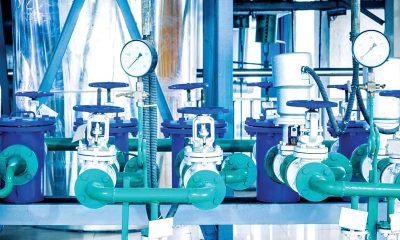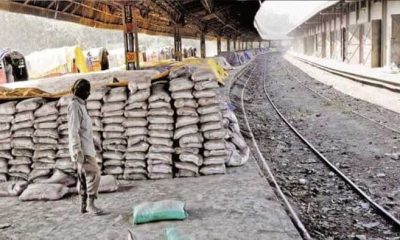Concrete
Environmental Benefits of Using Waste Glass as Pozzolana
Published
8 months agoon
By
admin
Dr SB Hedge, Professor, Jain University and Visiting Professor, Pennsylvania State University, United States of America, discusses the environmental benefits of using waste glass as Pozzolana in this concluding part of the article.
Pozzolanic properties of waste glass refer to its ability to react with calcium hydroxide in the presence of water to form cementitious compounds. This reaction, known as the pozzolanic reaction, contributes to the strength and durability of cementitious materials.
Findings based on the investigation on the Pozzolanic properties
Here are some details on the pozzolanic properties of waste glass and examples of its usage:
Amorphous Silica Content: Waste glass typically contains a significant amount of amorphous silica, which is a key factor in its pozzolanic activity. Amorphous silica has a high
surface area, allowing it to react readily
with calcium hydroxide and form additional cementitious compounds.
Reactivity and Fineness: The reactivity of waste glass depends on factors such as its chemical composition, particle size distribution, and surface area. To enhance its pozzolanic reactivity, waste glass is often ground to a fine powder. Increased fineness improves the contact between waste glass particles and calcium hydroxide, facilitating the pozzolanic reaction.
Pozzolanic Reaction Products: When waste glass reacts with calcium hydroxide in the presence of water, it forms additional cementitious compounds, such as calcium silicate hydrate (C-S-H) gel. The C-S-H gel contributes to the strength and binding properties of the
cementitious matrix.

Examples of Usage
Partial cement replacement: Waste glass can be used as a partial replacement for cement in concrete production. Typically, a portion of the cement is substituted with finely ground waste glass powder. This reduces the overall cement content while maintaining or improving the mechanical properties and durability of the concrete.
Glass powder addition in concrete mixes: Waste glass powder can be directly added to concrete mixes as an additional pozzolanic material. It acts as a supplementary cementitious material (SCM) alongside other pozzolanic materials like fly ash or silica fume. This combination enhances the reactivity and overall performance of the concrete.
Glass aggregate in concrete: In addition to using waste glass as a pozzolanic material, it can also be used as a fine or coarse aggregate in concrete production. By incorporating waste glass aggregates, both the pozzolanic and aggregate properties of the glass are utilised. This approach enhances the sustainability of concrete while maintaining structural integrity.
Glass fibre reinforcement: Waste glass fibres can be used as reinforcement in cementitious composites. The glass fibres provide tensile strength and improve the overall performance of the concrete. This application is particularly useful in construction elements requiring enhanced durability and crack resistance.
Glass as pozzolanic additive in mortars: Waste glass can be used as a pozzolanic additive in mortar mixes. Mortars containing waste glass exhibit improved workability, increased strength and reduced permeability. This makes them suitable for applications such as plastering, masonry and tile adhesives.
Waste glass possesses pozzolanic properties due to its high amorphous silica content. By utilising waste glass as a pozzolanic material, its environmental impact can be reduced while enhancing the performance and sustainability of cementitious materials.
The examples provided demonstrate the versatile usage of waste glass in cement and concrete applications, contributing to a more sustainable construction industry.

Environmental Benefits
The utilisation of waste glass as a pozzolanic material in cement production offers significant environmental benefits. Here is a detailed account of these benefits:
Waste reduction and recycling: Waste glass, if not properly managed, poses a significant environmental challenge. By using waste glass as a pozzolanic material, it is diverted from landfills or incineration, reducing the need for new disposal sites and minimising the environmental impact associated with glass waste. Recycling waste glass as a pozzolana promotes a circular economy by converting it into a valuable resource.
Conservation of natural resources: The incorporation of waste glass in cement production reduces the need for virgin raw materials, such as limestone or silica. By substituting a portion of cement with waste glass, natural resources are conserved, including the energy and water required for extraction and processing of raw materials. This conservation helps in preserving natural ecosystems and reducing the overall ecological footprint.
Energy savings and emissions reduction: The production of cement is energy-intensive and contributes to greenhouse gas emissions, primarily carbon dioxide (CO2). By using waste glass as a pozzolanic material, the cement content in concrete is reduced, resulting in lower energy consumption and CO2 emissions during cement manufacturing. This reduction in energy usage and emissions contributes to mitigating climate change and achieving sustainability goals.
Reduced landfill space and leachate generation: When waste glass is disposed of in landfills, it occupies valuable space and can contribute to environmental concerns. Glass waste in landfills may also produce leachate, potentially contaminating soil and groundwater. Utilising waste glass as a pozzolanic material reduces
the amount of glass waste sent to landfills, alleviating the pressure on waste management infrastructure and minimising the associated environmental risks.
Improved air quality: Cement production is associated with the release of pollutants, including dust, particulate matter, and potentially harmful gases. By replacing a portion of cement with waste glass, the production of cementitious materials can be optimised. The use of waste glass as a pozzolana reduces the overall emissions of particulate matter and improves air quality in and around cement plants, promoting a healthier environment for nearby communities.
Enhanced durability and reduced maintenance: Concrete incorporating waste glass as a pozzolanic material exhibits improved durability and reduced permeability. This translates into longer service life for concrete structures, reduced maintenance requirements, and decreased need for repairs or replacements. By extending the life of concrete, the environmental impact associated with new construction projects is minimised.
Waste Glass Addition
The addition of waste glass to concrete can significantly improve its performance in several ways. Here are the key ways in which waste glass enhances the performance of concrete:
- Increased strength and durability: The incorporation of waste glass as a pozzolanic material in concrete leads to the formation of additional cementitious compounds. These compounds, such as calcium silicate hydrate (C-S-H) gel, contribute to the strength and durability of the concrete. The pozzolanic reaction between waste glass and calcium hydroxide results in denser and more compact concrete, improving its compressive and flexural strength.
- Reduced permeability: Concrete containing waste glass exhibits reduced permeability to water and other potentially harmful substances. The pozzolanic reaction of waste glass results in the formation of a refined pore structure within the concrete matrix. This refined pore structure restricts the movement of water and other aggressive agents, enhancing the concrete’s resistance to moisture ingress, chemical attack, and freeze-thaw damage.
- Enhanced chemical resistance: The pozzolanic reaction of waste glass in concrete leads to the formation of calcium silicate hydrate (C-S-H) gel, which provides improved chemical resistance. This resistance makes the concrete less susceptible to chemical degradation caused by substances such as sulphates, chlorides and acids.
Concrete with waste glass as a pozzolanic material exhibits better long-term performance in aggressive environments. - Improved workability and cohesion: The addition of waste glass as a pozzolanic material can enhance the workability and cohesion of concrete. Due to the fine particle size and pozzolanic nature of waste glass, it acts as a filler material, improving the packing and lubrication of the concrete mixture. This improved workability allows for easier placement, consolidation, and finishing of
the concrete. - Mitigation of alkali-silica reaction: Alkali-Silica Reaction (ASR) is a chemical reaction that can occur between certain reactive silica minerals in aggregates and the alkalis present in cement. This reaction can lead to expansive cracking and deterioration of concrete. Waste glass, being an inert material, can act as a mitigating agent for ASR by replacing some of the reactive silica in the concrete mix.
- Sustainability and eco-friendliness: In addition to performance improvements, the utilisation of waste glass in concrete contributes to sustainability and eco-friendliness. By incorporating waste glass as a pozzolanic material, the consumption of cement is reduced, resulting in CO2 emissions associated with cement production. This reduction in CO2 emissions aligns with environmental goals and contributes to a more sustainable construction industry.
Challenges and Considerations
The utilisation of waste glass as a pozzolanic material in cement production does pose some challenges. Proper processing and grinding of waste glass to achieve optimal fineness is crucial to ensure its reactivity. The potential presence of impurities in the waste glass, such as metals or contaminants, requires careful selection and pre-treatment. Additionally, the impact of incorporating waste glass on the fresh and hardened properties of concrete should be evaluated to ensure compatibility with specific project requirements.
Research and Industry Initiatives
Ongoing research and industry initiatives are focused on optimising the use of waste glass as a pozzolanic material. Studies explore various methods of processing and grinding waste glass to enhance its reactivity and maximise its utilisation. Additionally, there is a scope to investigate the influence of waste glass characteristics, such as particle size, composition and treatment, on the properties of concrete. These efforts aim to develop guidelines and standards for incorporating waste glass in cement production.
Conclusion
The use of waste glass as a pozzolanic material in cement production offers a sustainable solution to address environmental concerns associated with both waste glass disposal and cement manufacturing. By harnessing the pozzolanic properties of waste glass, cement producers can reduce their carbon footprint, enhance concrete performance, and contribute to a more circular economy.
The addition of waste glass as a pozzolanic material significantly enhances the performance of concrete. The improvements include increased strength and durability, reduced permeability, enhanced chemical resistance, improved workability and cohesion, mitigation of alkali-silica reaction and sustainability benefits. By embracing waste glass in concrete production, the construction industry can create more resilient and eco-friendly structures while effectively utilising a valuable waste material.
Further research, collaboration and implementation efforts are essential to fully exploit the potential of waste glass as a valuable resource.
References
- Utilisation of Waste Glass Powder in Concrete by P. Manoj Kumar, K. Sreenivasulu, and M. Srinivasulu Reddy, International Journal of Innovative Research in Science, Engineering and Technology, 2013.
- Recycling of Waste Glass as a Partial Replacement for Fine Aggregate in Concrete Mix by W. A. Rahman, M. A. S. Al-gahtani, and M. A. K. El-Kourd, Journal of King Saud University – Engineering Sciences, 2010.
- Mechanical and Durability Properties of Concrete Containing Glass Powder as Partial Replacement of Cement by A. Shayan and R. Xu, Construction and Building Materials, 2004.
- Properties of Glass Concrete Containing Fine and Coarse Glass Aggregates by Z. Feng, S. Xie, and Y. Zhou, Journal of Materials in Civil Engineering, 2011.
You can find part one in the August issue of Indian Cement Review.
ABOUT THE AUTHOR
Dr SB Hegde is a Professor at Jain University and a Visiting Professor at the Pennsylvania State University, United States of America.
Concrete
JK Cement Boosts Production Capacity with New Production Line at Panna Plant
Published
1 week agoon
April 29, 2024By
admin
JK Cement hasannounced the inauguration of a new production line at its Panna Plant. This development marks a significant milestone in the company’s expansion strategy and reaffirms its commitment to meeting the growing demand for cement while setting its position as a key industry player.
The new production line at the Panna Plant effectively doubles its clinker production capacity to 6.6 million metric tons per annum (MTPA), up from the previous 3.3 MTPA. This expansion positions JK Cement to cater efficiently to the increasing demand for cement across Uttar Pradesh, Bihar, and Central India.
Dr Raghavpat Singhania, Managing Director, JK Cement Ltd., said, “JK Cement is built on a foundation of growth and expansion. Our new Panna Plant production line is a key pillar in our comprehensive business expansion plan, propelling us towards our vision of becoming a leading player in the cement industry. This strategic expansion allows us to meet the rising demand for high-quality cement, ultimately enhancing our ability to serve our customers. We remain committed to delivering value to all stakeholders and contributing to the nation’s development.”
Madhavkrishna Singhania, Deputy Managing Director and CEO, JK Cement Ltd., commented, “The launch of our new production line underscores JK Cement’s unwavering commitment to achieving long-term growth and operational excellence. This expansion empowers us to optimize production processes, unlock our full potential, and position ourselves for the future of the cement industry.”
The new production line integrates advanced automation systems for precise control and monitoring, minimising human intervention and enhancing efficiency. State-of-the-art machinery and equipment ensure optimal performance, reliability, consistent output quality, and energy efficiency, reflecting JK Cement’s commitment to sustainability. The plant incorporates energy-saving technologies, optimised kiln systems, and waste heat recovery systems to reduce energy consumption and lower the carbon footprint. Stringent quality control measures in the plant guarantee that cement products meet the highest industry standards.
Additionally, the Panna Plant expansion project generates employment opportunities, contributing to socio-economic growth in the region. JK Cement actively engages with the local community through educational, healthcare, and social initiatives, strengthening its bond with stakeholders.
With a significant investment of Rs. 2850 Cr, the Panna Plant expansion project reflects JK Cement’s vision for sustainable growth, environmental protection, and contribution to economic and social development in the region.
Concrete
Making durable concrete by using ternary blend
Published
1 week agoon
April 27, 2024By
admin
Cement, flyash, ground granulated blast furnace slag(GGBFS) are the key components in the ternary blend used to make concrete. Nagesh Veeturi and Sumanta Sahu of KEC International – Civil Business, shed light on reducing the carbon footprint of cement production by using supplementary cementitious materials.
Cement is prime ingredient in concrete. One tonne of cement produces around 0.8 to 1 MT of carbon dioxide. It’s worth noting that efforts are being made to reduce the carbon footprint of cement production by using supplementary cementitious materials such as flyash and GGBS in concrete. In case of ternary blended concrete, supplementary cementitious materials flyash and GGBS are used in addition to cement, sand, aggregate, water and admixture.
To evaluate the percentage of replacement of cement with flyash and GGBS, one needs to understand the properties of concrete mix with flyash and GGBS as ingredients, structure strength, stripping time and durability requirements.
Properties of Supplementary Cementitious Materials
Flyash
Pulverised coal is used in thermal power plants for electricity generation. A by-product of this combustion reaction is fly ash. The electrostatic precipitators (ESPs) used inside chimneys of the power plants remove flyash before ejecting out the combustion gases into the atmosphere. Fly ash is a very fine particle like residue, which has pozzolanic properties. Hence it is often blended with cement and also used as partial replacement of cement.
Fly ash consists of silica (SiO2), alumina (Al2O3) and calcium oxide (CaO) as its major components. Fly ash can be of two types – C type and F type. C type fly ash is rich in calcium oxide and possesses both cementitious and pozzolanic properties whereas F type fly ash is low in calcium oxide content and possesses only pozzolanic properties.
- Due to spherical shape of flyash, water demands in concrete is reduced, concrete becomes more cohesive.
- Silica in flyash reacts with calcium hydroxide released from cement to form CSH Gel, Formation of CSH Gel leads to increase in strength of concrete further and make the concrete dense and durable.
- 35 per cent of cement can be replaced with flyash according to IS specification. However, for mass concrete high volume flyash up to 50 per cent can be used.
- Early strength observed to be less for flyash concrete.
- Due to slow development of strength of concrete, stripping time gets delayed.

(Flyash produced from Thermal Power Plant)
Ground Granulated Blast Furnace Slag (GGBFS)
Blast furnace slag is a by-product of iron ore during iron extraction process. Amongst all mineral admixtures, blast furnace slag has the highest specific gravity (2.8 to 3.0). Typically, the slag fineness is slightly more than that of the cement.
There are various types of slag available like air cooled slag, expanded or foamed slag, granulated slag. Among these only the granulated slag is commonly used as a mineral admixture. It is a highly reactive form of slag and is usually quenched to form a hardened matter which is then grounded into particles of fineness almost same as that of cement. Hence the material is called as ‘ground granulated blast furnace slag’.
GGBFS possesses both cementitious and pozzolanic properties. An activator is needed to hydrate the slag.
- GGBFS increases the initial setting time of the concrete. But it does not alter the workability of the concrete much because its fineness is almost same as that of the cement.
- The early rate of strength gain in concrete is diminished by replacement of cement in the concrete with GGBFS.
- The final strength is improved by slag cement and also the durability of the concrete is increased.
- Concrete uses in marine construction are highly prone to chemical attack and corrosion. GGBFS as a concrete ingredient increases resistance against sulphate and chloride attack.
Normally concrete tends to segregate with GGBS as ingredient,


(GGBFS produced from Steel Plant)\
Concrete with flyash and GGBS as ingredients (Ternary Blend)
Ternary blended concrete is observed to be more cohesive and workable due to presence of flyash in concrete. Early strength gain can be achieved by using both Cement and GGBS in concrete. Concrete with ternary blend is win-win situation in terms of good product quality, optimising the cost of concrete, durability and resistance against chemical attack. Additionally, the use of SCMs in concrete can contribute to sustainability efforts by minimizing the cement content which is associated with significant carbon dioxide emission during its manufacturing process.
The hydration process of ternary blended concrete is divided into primary reaction by OPC and GGBS, pozzolanic reaction of GGBS and flyash as the secondary process. Both materials react with Calcium hydroxide produced by cement hydration to form CSH gel, which gives denser microstructure than conventional OPC concrete. The dense structure improves the durability properties of ternary blended concrete. Process yields to minimise penetration of aggressive chemicals such as sulphate, chloride as compared to conventional concrete mix.
Conclusion
Use of supplementary cementitious materials always improve the durability properties of concrete along with cost optimisation. Selection of supplementary cementitious materials, percentage replacement with cement is taken considering the strength and durability requirements of structure.

Ultratech Cement will once again use the state-of-the-art vertical roller mill technology from Gebr. Pfeiffer, to build three new clinker production lines.
As Ultratech Cement gears up for its three new clinker production lines, a corresponding follow-up order was awarded to Gebr. Pfeiffer SE, Germany, and its Indian subsidiary Gebr. Pfeiffer (India).
As the largest cement plant operator in India and one of the top ten in the world, Ultratech Cement from Mumbai, India, is contributing to shaping the future of the cement industry. At their Happy 3 plant, the cement raw material will be ground in an MVR 5000 R-4 mill. With a 5,300-kW drive, this mill can grind approx. 705 tph to a product fineness of 1.5 per cent R 212 µm. The integrated SLS 5300 VR high-efficiency classifier, with optimised flow and electrical efficiency, separates the product to achieve the target fineness.
For the grinding of approx. 45 t/h of pet coke or approx. 90 t/h of coal, three vertical roller mills of the type MPS 3550 BK will be supplied. These are equipped with a 1,300-kW gearbox, as standard. By using Pfeiffer MPS mills, Ultratech is able to process both pet coke and coal, as well as any mixture of these two materials, at the same speed of the grinding bowl, thus avoiding three expensive frequency converters. The new coal mills will be equipped with an integrated high-efficiency classifier type SLS 3750 BK of the latest design.
It is important for UltraTech’s stock of spare parts that the latest MVR mills are characterised by grinding rollers based on the R=C principle, as this brings significant advantages for the customer. It means that these mills are equipped with grinding rollers that, equipped with the corresponding grinding elements, can be used, along with the appropriate power modules, for raw meal grinding as well as for cement grinding.
As the components of rollers, grinding roller suspension system, roller arms in cement and raw mills are identical with the ones which the customer has already received from Gebr. Pfeiffer, he requires a smaller number of spare parts in stock. This is because the components mentioned can be used for all his cement and raw mills.
The MVR 5000 R-4 mill for the Happy 3 plant has four actively redundant grinding rollers and can also be operated with two grinding rollers in the event of planned or unplanned maintenance work. This mill can then still produce approximately 70 per cent of the nominal capacity, so that the cement rotary kiln can continue to be fed with raw material.
The MVR mills are equipped by Gebr. Pfeiffer with the modern systems for preventive, maintenance-oriented condition monitoring. This will enable the customer to implement modern, digital maintenance concepts. The MPS mills will be prepared to include such options at a later point in time.
Order execution will be jointly by the subsidiary Gebr. Pfeiffer (India) and Gebr. Pfeiffer SE (Germany). The entire customer support and plant engineering will be carried out by competent Pfeiffer engineers in Noida.
The core components, such as gearbox, grinding bowl, grinding roller suspension system and the grinding rollers, are supplied from Europe by Gebr. Pfeiffer SE. The remaining components, such as the foundation parts, the housings, the classifiers and most of the plant components will be provided by Gebr. Pfeiffer (India).
The Customer Support Centre in Noida, being close to the customer, will later also provide support for the plants. This can be done in real terms by sending personnel to the plants or via remote data access.
For this purpose, Gebr. Pfeiffer offers hardware and software solutions, which are supported by competent technical personnel during normal office hours, if possible, in the local language. The picture shows an MVR mill of similar size (Type MVR 5000 R-4).

JK Cement Boosts Production Capacity with New Production Line at Panna Plant

Making durable concrete by using ternary blend

Ultratech sources VRM from Gebr. Pfeiffer

RAHSTA to showcase cutting-edge road construction tech, says NCC Director

RAHSTA will drive road construction innovation: Sundaresan

Environment Ministry revises rules of solid waste management

M-sand boards new terrain
Concrete: A Highly Sustainable Building Material

Process and quality optimization in cement plant.






















